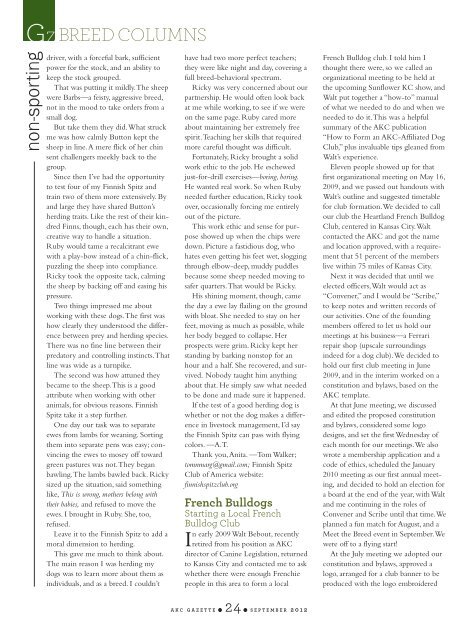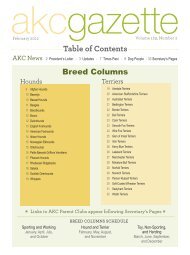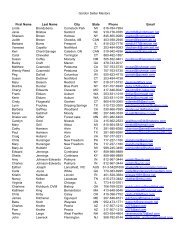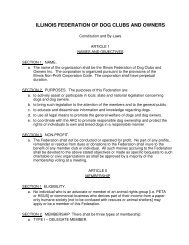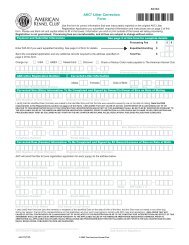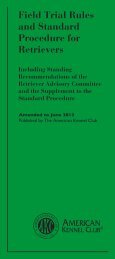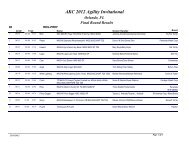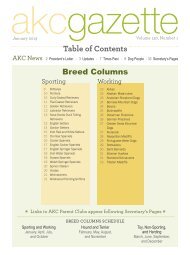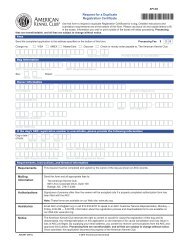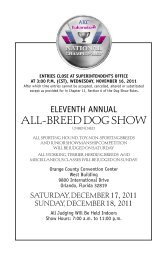Download - Parent Directory - American Kennel Club
Download - Parent Directory - American Kennel Club
Download - Parent Directory - American Kennel Club
- No tags were found...
You also want an ePaper? Increase the reach of your titles
YUMPU automatically turns print PDFs into web optimized ePapers that Google loves.
GZ BREED COLUMNSnon-sportingdriver, with a forceful bark, sufficientpower for the stock, and an ability tokeep the stock grouped.That was putting it mildly. The sheepwere Barbs—a feisty, aggressive breed,not in the mood to take orders from asmall dog.But take them they did. What struckme was how calmly Button kept thesheep in line. A mere flick of her chinsent challengers meekly back to thegroup.Since then I’ve had the opportunityto test four of my Finnish Spitz andtrain two of them more extensively. Byand large they have shared Button’sherding traits. Like the rest of their kindredFinns, though, each has their own,creative way to handle a situation.Ruby would tame a recalcitrant ewewith a play-bow instead of a chin-flick,puzzling the sheep into compliance.Ricky took the opposite tack, calmingthe sheep by backing off and easing hispressure.Two things impressed me aboutworking with these dogs. The first washow clearly they understood the differencebetween prey and herding species.There was no fine line between theirpredatory and controlling instincts. Thatline was wide as a turnpike.The second was how attuned theybecame to the sheep. This is a goodattribute when working with otheranimals, for obvious reasons. FinnishSpitz take it a step further.One day our task was to separateewes from lambs for weaning. Sortingthem into separate pens was easy; convincingthe ewes to mosey off towardgreen pastures was not. They beganbawling. The lambs bawled back. Rickysized up the situation, said somethinglike, This is wrong, mothers belong withtheir babies, and refused to move theewes. I brought in Ruby. She, too,refused.Leave it to the Finnish Spitz to add amoral dimension to herding.This gave me much to think about.The main reason I was herding mydogs was to learn more about them asindividuals, and as a breed. I couldn’thave had two more perfect teachers;they were like night and day, covering afull breed-behavioral spectrum.Ricky was very concerned about ourpartnership. He would often look backat me while working, to see if we wereon the same page. Ruby cared moreabout maintaining her extremely freespirit. Teaching her skills that requiredmore careful thought was difficult.Fortunately, Ricky brought a solidwork ethic to the job. He eschewedjust-for-drill exercises—boring, boring.He wanted real work. So when Rubyneeded further education, Ricky tookover, occasionally forcing me entirelyout of the picture.This work ethic and sense for purposeshowed up when the chips weredown. Picture a fastidious dog, whohates even getting his feet wet, sloggingthrough elbow-deep, muddy puddlesbecause some sheep needed moving tosafer quarters. That would be Ricky.His shining moment, though, camethe day a ewe lay flailing on the groundwith bloat. She needed to stay on herfeet, moving as much as possible, whileher body begged to collapse. Herprospects were grim. Ricky kept herstanding by barking nonstop for anhour and a half. She recovered, and survived.Nobody taught him anythingabout that. He simply saw what neededto be done and made sure it happened.If the test of a good herding dog iswhether or not the dog makes a differencein livestock management, I’d saythe Finnish Spitz can pass with flyingcolors. —A.T.Thank you, Anita. —Tom Walker;tomnmarg@gmail.com; Finnish Spitz<strong>Club</strong> of America website:finnishspitzclub.orgFrench BulldogsStarting a Local FrenchBulldog <strong>Club</strong>In early 2009 Walt Bebout, recentlyretired from his position as AKCdirector of Canine Legislation, returnedto Kansas City and contacted me to askwhether there were enough Frenchiepeople in this area to form a localFrench Bulldog club. I told him Ithought there were, so we called anorganizational meeting to be held atthe upcoming Sunflower KC show, andWalt put together a “how-to” manualof what we needed to do and when weneeded to do it. This was a helpfulsummary of the AKC publication“How to Form an AKC-Affiliated Dog<strong>Club</strong>,” plus invaluable tips gleaned fromWalt’s experience.Eleven people showed up for thatfirst organizational meeting on May 16,2009, and we passed out handouts withWalt’s outline and suggested timetablefor club formation. We decided to callour club the Heartland French Bulldog<strong>Club</strong>, centered in Kansas City. Waltcontacted the AKC and got the nameand location approved, with a requirementthat 51 percent of the memberslive within 75 miles of Kansas City.Next it was decided that until weelected officers, Walt would act as“Convener,” and I would be “Scribe,”to keep notes and written records ofour activities. One of the foundingmembers offered to let us hold ourmeetings at his business—a Ferrarirepair shop (upscale surroundingsindeed for a dog club). We decided tohold our first club meeting in June2009, and in the interim worked on aconstitution and bylaws, based on theAKC template.At that June meeting, we discussedand edited the proposed constitutionand bylaws, considered some logodesigns, and set the first Wednesday ofeach month for our meetings. We alsowrote a membership application and acode of ethics, scheduled the January2010 meeting as our first annual meeting,and decided to hold an election fora board at the end of the year, with Waltand me continuing in the roles ofConvener and Scribe until that time. Weplanned a fun match for August, and aMeet the Breed event in September. Wewere off to a flying start!At the July meeting we adopted ourconstitution and bylaws, approved alogo, arranged for a club banner to beproduced with the logo embroideredA K C G A Z E T T E • 24 • S E P T E M B E R 2 0 1 2


